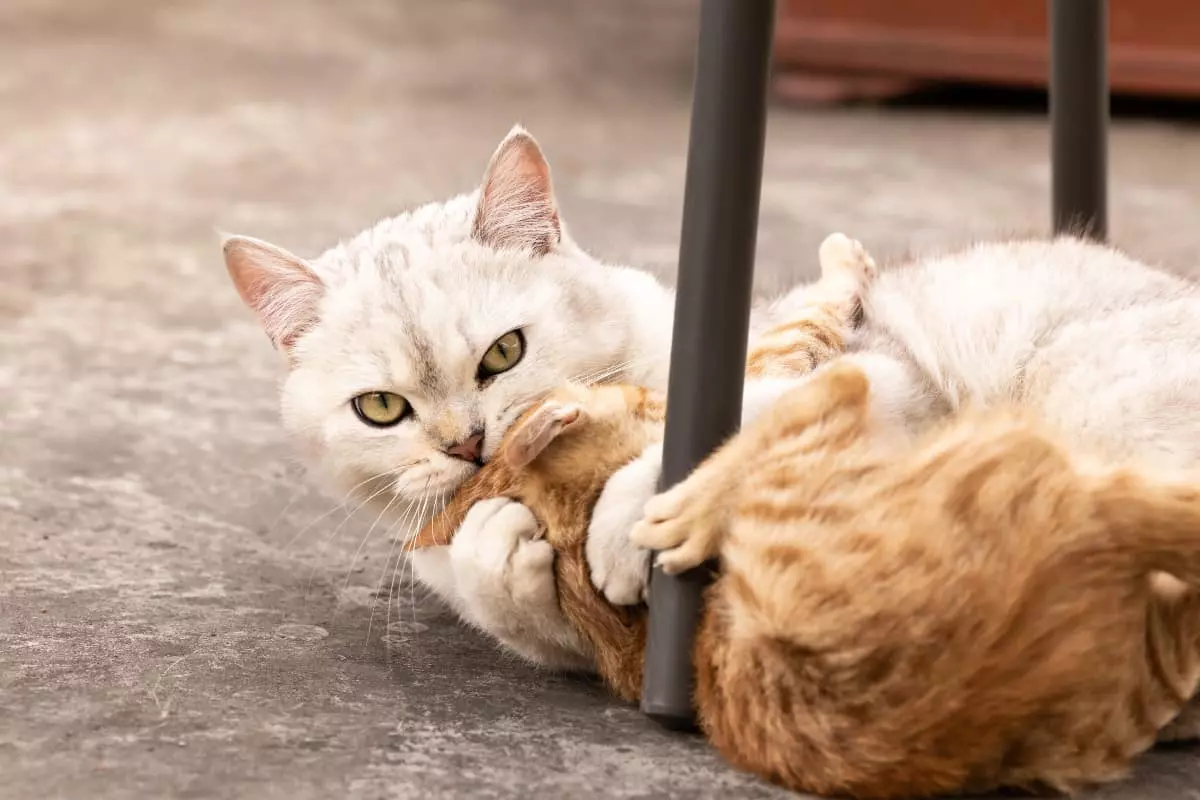
Having more than one cat has plenty of benefits, but you may find that some cats need help learning how to get along with others. This article will provide easy tips and tricks for how to stop my cat from bullying my other cat!
Cats are relatively low-maintenance pets, so having multiple cats in your home is common. Even though cats are commonly thought to be pack animals because of their larger and wilder relatives, cats are not instinctually drawn to colonies or packs.
Some feral cats may form small colonies in the wild, but this is not common. Cats are solitary hunters, and their survival instincts are not based on a pack mentality.
That being said, this will have no bearing on whether or not your house cats will get along with each other.
Before we dive into how to stop a cat from being a bully, let’s cover whether having more than one cat is a good idea.
Benefits of Having Multiple Cats
Cats are like chips - bet you can’t have just one! Having more than one cat is often easier than having more than one dog because cats are usually more independent. Their small size makes them better suited for people with busier schedules, and they can adapt to apartments and smaller homes more easily than a dog.
Most pet parents end up with a second cat (or third) just because they love these fluffy and playful creatures, but did you know that there are some real benefits to getting another cat?
Here are some of the best benefits of having multiple cats in your home:
Boredom
You may not realize that your cat can get bored, especially if they are home alone during the day. Sure, cats spend a lot of their downtime napping, but the time they are awake should offer plenty of mental stimulation.
A common reason you might get a second cat is to give your cat someone to play with. An additional kitty can provide affection in your absence.
Social Skills
Basic cat behaviours and social skills are learned from their mother and litter mates at a very young age. The rest is learned through experience and environment.
Many solo cats learn to adapt to their human families' behaviours, but adding a new cat to the mix can allow your cat to express more cat behaviours. A second cat can help to teach your cat some feline social cues that may have been forgotten since they were last with their siblings.
Increased Activity
Lazy cats can benefit from a sibling relationship too. Kitty playtime can encourage more physical activity, even in fat or lazy cats. Activity can range from low-impact wrestling to more lively games of chase or racing.
Grooming
Cats love to groom themselves, but they groom each other too. Cats that don’t have the best self-grooming skills can benefit from a partner who will either pick up the slack or show them how to groom better.
Getting a Second Cat
If you are concerned that your cat is lonely, then getting a second cat might seem like the right thing to do, but despite the benefits above, a second cat isn’t always the best choice for every home. The addition of another cat could enrich your first cat's environment, but in some cases, it could cause problems.
As a solitary species, domestic cats don’t need a sibling to be happy, and some cats would prefer to stay an only fur child. Your cat's temperament will be a good indicator of whether or not a new cat would be well received in your home.
Here are some of the negative consequences you could see with the addition of a new cat:
Double Trouble
If your goal in getting a second cat is to help curb some naughty cat behaviours, you run the risk of having twin disasters. Often when cats get along well, they enjoy the same activities, and you may have the misfortune of your mischievous cats teaming up and doing more damage then they could do alone.
Cat Fights
Even cats who typically get along get on each other's nerves. Siblings fight, but the severity of the cat fights is what is important. A fight between bonded siblings should be quick and leave no damage, but a real cat fight can get dangerous quickly.
Jealousy
A new cat, like a new baby, can evoke some jealousy in your older pets. While a jealous cat may not be aggressive towards the other cats, they may be aggressive to you or start acting out in protest. Litter box habits and eating behaviours can change, or your cat may be less social whenever affection or attention is given to the new cat.
Space Restraints
One cat may do fine in a small apartment, but multiple cats will need more space. Not only do they need shared space for activity, but they also need space away from each other. The more cramped they are, the more likely they will scrap when they are feeling grumpy.
Consider how a new cat will affect not just you but all of your current pets. The choice to get another cat should be based on whether or not a new sibling is best for your animal family and whether you have the time to help your new and old pets learn to co-exist.
Understanding Cat Bullying
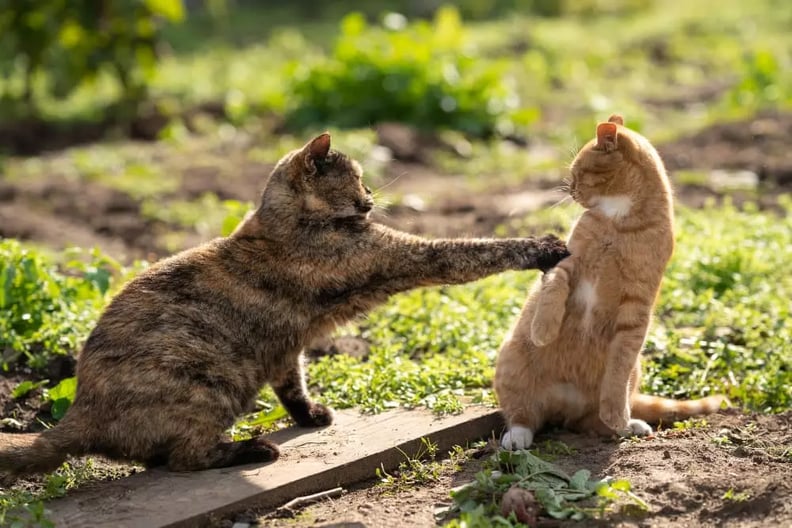
One common issue with multi-cat households is that one cat may present with more dominant or aggressive habits. If one of your cats is being a bully, you need to make some changes before someone gets hurt.
Cat bullying can take on many forms, and while aggressive behaviours are the easiest to spot, it’s important to recognize other signs that one of your cats is being bullied by the other.
Cat Fighting
Cat fights between siblings can look more violent than they actually are, but that doesn’t mean your cats won’t get injured. In some cases, it can be hard to tell the difference between play fighting and real fighting.
Cats might make a lot of noise and move quickly when play fighting, but there are easy-to-spot body language signals that indicate that this fight is not so playful. Look at your cat’s body language, as this will be a good litmus test for how aggressive their “play fights” are getting.
Aggressive Cat Bullying
An angry, scared, or defensive cat will typically display easy-to-spot body language. Fluffing of the fur, especially on the back and tail, will make your cat look bigger and more intimidating. This is a common show of force in many animal species.
Other common markers of aggression in cats include tail shaking (think rattlesnake), a high-arched back, long and low growling, and hissing.
These are all warning signs for cats. They are telling the other to back off, or it’s on! From here, tension will rise further.
Warning shots may be fired in the form of a swat (claws out), and the growling may turn to a higher-pitched screech or sharp yell. These common cat fight noises mean that the cats have engaged each other, and you need to intervene immediately.
Passive Aggressive Cat Bullying
Bully cats aren’t always violent, though catfights are a good indicator that your cats aren’t getting along well. In some cases, one cat might bully another by being more passive-aggressive than aggressive-aggressive.
Here are some of the more subtle cat-bullying tactics that you might see:
-
-
- Hogging food
- Taking up more space on the bed
- Monopolizing more of your time and affection
- Stealing toys
- Not covering waste in the litter box
- Guarding or blocking rooms and doorways
-
These signs often get overlooked or downplayed, but this type of non-combative bullying can escalate as the tension between the cats builds.
Why Do Cats Bully Other Cats
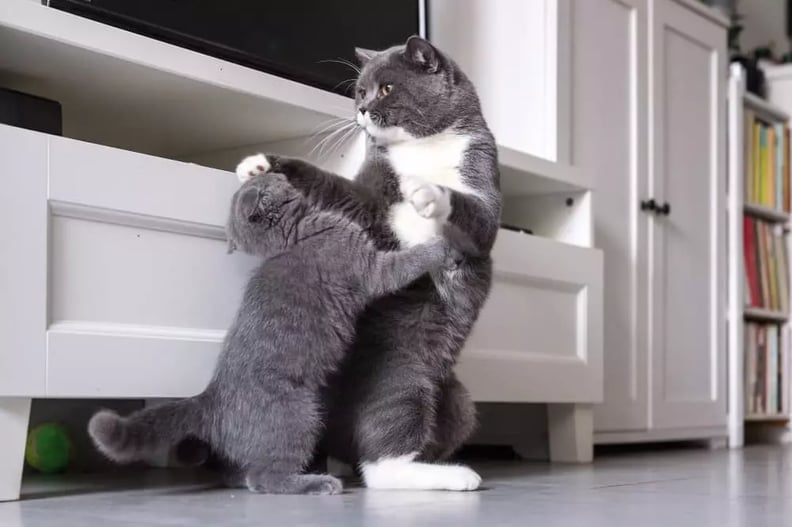
Understanding why one cat might be picking on another is helpful in teaching them to get along or at least leave each other alone. Cats bullying other cats is very common, even in the wild. As lone wolves, cats are always in competition for resources.
In the wild, those resources include food and shelter, but in your safe and comfortable home, the resources they fight over could be your attention, the sunniest window in the house, or that coveted spot behind your knees when you sleep.
It’s also important to consider possible triggers for this bullying behaviour in cats. Changes to their environment or routine can cause your cat to feel anxious or stressed.
There are also some situations when cat bullying is more common:
My Older Cat Keeps Attacking New Kitten
If your old cat has been the only child for a long time, she is likely to be less than thrilled with the addition of this young whipper snapper interrupting her cat naps.
Kittens tend to be more annoying to older cat, especially ones in their senior stage of life. Kittens are playful, affectionate, and curious, while your old cat might just want to be left alone. This can trigger an older cat to be a bit of a jerk to your new kitten.
It may start with hissing and some warning signs, but kittens tend not to get the message right away, so your senior cat may get more aggressive as a way of teaching your kitten to back off.
Though your older cat may soften to the kitten in time, the real problem is that kittens are much smaller and more fragile, so the risk of injury is much higher.
Cats Suddenly Fighting
When cats have historically gotten along well, or at least tolerated each other, sudden scraps and cat fights can be alarming. Why would your cats suddenly start fighting?
There can be many answers to this question, but most commonly, the cause is a sudden environmental change. Moving to a new house, losing a friend or family member, big schedule changes or other major events can make your cats anxious, leading to unusual behaviour around each other.
Other reasons for sudden bullying behaviours from one cat to another can include:
-
- Your cats don't have enough space
- Boredom and limited exercise
- Hormonal changes during heat cycles, sexual development in unaltered cats, and pregnancy
- Illness or injury
Talk to your vet to rule out injury and ask about the best steps to take for managing issues due to hormone changes. Make sure your cats are both mentally and physically active throughout the day too. This will reduce anxiety or frustrations due to boredom.
How to Introduce Cats to Each Other

The introduction may be the most important step in introducing a new cat to your old cats. A new cat can be an alarming and unwanted surprise for your current cat(s), and if you don’t let them introduce themselves the right way, you will likely get an unpleasant response from one or both of the cats.
This process can also be helpful when correcting bully behaviours in cats who are already familiar with each other. Starting from scratch and slowly re-introducing them can be an effective way to ease tensions between siblings.
The introduction process requires time and patience, and the more you try to rush it, the more you could end up raising the tension between the pets.
Every cat is different, so introductions between cats will depend on each cat's personality and tolerance. There will be some trial and error to find the best method for your cats in your home. That being said, there are some basic steps that you can try and modify as needed to help your cats get used to each other.
There will be three stages to this process: Preparing your home for a new cat, no-contact introductions, and first contact.
Stage 1: Preparing Your Home
New Accessories
Though some of your cat’s things can be shared, your new cat will require some of his own things. A second litter box, a feeding bowl, and some toys or scratchers are a good idea.
If each cat has their own things, it may limit aggression or jealousy between the cats while they get used to each other.
Make a Safe Space for Them
Your new cat will need a space that is free of other pets, so set up a spare room with a clean litter box, fresh cat litter, food and water bowls, and a comfortable bed for your new kitty.
This will be a safe space for them to destress after their trip home without the intimidation of meeting your other cat just yet.
Stage 2: No Contact Introductions
Swap Scents
Once your new cat is settled in, you can start to introduce them to each other's scents. This involves taking something, like a towel or a bed that has each cat’s scent on it, and swapping them.
Food and treats are a great way to help cats associate scents, sounds, and sights with a positive feeling. If the cat approaches the bed with the other cat’s scent, then reward them with a tasty morsel of food or a high-value cat treat.
Another way to do this is to swap their food and water bowls. This will further associate the other cat’s pheromones with food.
After they’ve adapted to living with each other's scents, you swap the cats. This will give your new cat a chance to explore the rest of the house without being intimidated by your other cat.
Visual Contact
When both cats seem calm in the other’s space, then you can try allowing them to see each other. This visual contact can be done through a baby gate, a window, or even a screen door.
Make sure to give both cats treats and affection to reassure them that they are in no danger.
This step isn’t strictly necessary but can be a helpful step for cats showing increasingly anxious behaviours at the sounds and smells of the other cat.
Stage 3: First Contact
Choose a Neutral Room
It’s good to have the cats finally meet in neutral territory. Use a meeting room where your old cat isn’t overly attached to prevent territorial behaviour. The area should be large enough to allow both cats to move around without being in each other's faces but not so big that you can’t keep track of both of their movements.
Have Some Faith
Place both cats in the room, but not too close. You want them to see each other, but let them choose if they want to approach. They may spend the first couple of tries in opposite corners, and that’s ok.
This step can be done in short sessions at first and then in longer sessions as the cats begin to interact appropriately. Always supervise them until you are sure they are friends.
Keep treats on hand to reward for good behaviour and willingness to interact, even from a distance.
Introducing a New Cat
Some cats will be instant friends, while others may take weeks or even months to be comfortable with each other. And in some unfortunate cases, your cat may never be friends.
It’s important to be patient and understanding of the anxiety and fear that your cats may experience and allow them to interact organically as much as possible.
Do not push them together if they choose to sit apart or hide. In time, they will get curious enough and brave enough to interact.
How to Introduce Cats Fast
If you are wondering how to introduce cats quickly, then your best bet is to choose a room with a small gap under the door, like a door over a tile or a laminate floor. This would allow your cats to sniff and interact with each other.
The contact will be minimal, but this interaction can take away some of the fear of the unknown. There may be some initial hissing and noise, but often, cats will calm down once the initial shock is over.
With this step, you may find that you won’t need to keep the cats separate for as long. The slow process of introducing each other's scents by swapping accessories may not be necessary if both cats are reacting favourably to each other through the door.
If you are lucky enough to have cats that are friendly and have experience meeting new cats, you may find that after the initial day of separation, they can be immediately introduced to each other.
If this works for you, that’s great, but no matter how confident you are, be prepared to separate the cats and introduce them slowly if either cat reacts poorly.
How to Stop Cat Aggression Towards Other Cats
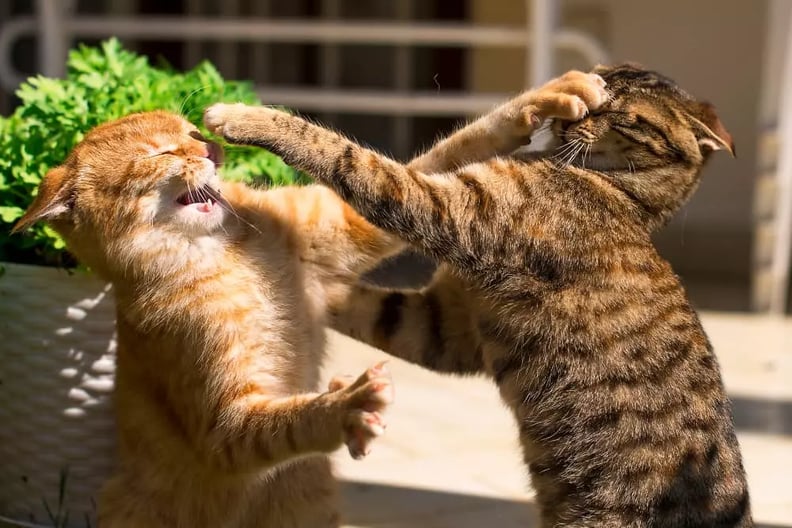
Aggression and other bullying behaviours between cats can escalate if not addressed. Whether these behaviours are present from day one or have developed over time, taking steps to understand the dynamic between your cats and finding ways to help them learn to co-exist is the best way to bring harmony to your house.
Introductions are very important, but if you are seeing new cat bullying behaviours in your established cat family, then there are still plenty of ways to help your cats get along better.
1. Supervise Interactions
Keep a close eye on the cats. Watch their body language and movements when they interact to determine signs that they could start to scrap. If you can identify how your cats show aggressive or bullying behaviours, you may be able to intervene before a catfight starts.
2. Identify Areas of Contention
Sometimes, one cat may feel territorial over certain spaces or objects. Your cat may have a favourite room, window, bed, or even person that they don’t want to share with a new cat.
Identifying these triggers for cat aggression can help you make peace between your cats. You may need to limit their access to some areas or spend time separately with each cat to avoid jealousy.
3. Create Positive Associations
Though the cats may not get along now, that doesn’t mean they never will. Stubborn cats may need lots and lots of practice and positive association training to get them used to sharing their space with a new cat.
Whenever the cats are together, keep treats and toys on hand to reward them for calm and even tolerant behaviour. If either cat shows aggression, calmly separate them and let them relax.
In time, your cats will start to associate a reward with positive behaviour around each other and hopefully get them to a place where they can cohabitate peacefully.
What To Do When Your Cats Don’t Get Along
Sometimes no matter how hard you try, and no matter how ideal the circumstances are, some cats will never get along. It may not be what you want to consider, but keeping cats that don't get along can lead to anxiety, destructive behaviours, and possible injury.
If you have tried everything to help your cats learn to accept each other, but it’s just not working, then you still have a few options. There are upsides and downsides to these plans b’s so make sure you make the choice that is safest for your cats and most reasonable for you and your family.
Here are some options for taking care of cats that hate each other:
1. Give Each Cat a Separate Space in the House
If your cats are not friends, then you may have to settle for tolerance. Some cats may not be able to spend time together alone, but when supervised may co-exist in your home so long as they give each other enough space.
This means having separate areas for each cat to go to when they can’t be supervised. Try to be fair about how much room each cat has when unsupervised.
2. Contact a Trainer
Some kitty behavioural problems may be more than you can handle on your own. Talk to a trainer or your vet to help you find alternative solutions for stopping a bully cat.
3. Think about Rehoming
This is a last resort, of course, but for the safety of both cats, you may need to consider rehoming your new cat. This isn’t an easy decision to make, so take some time and try all other possible options, but you need to do what is best for both cats.
Be Patient When Introducing a New Cat
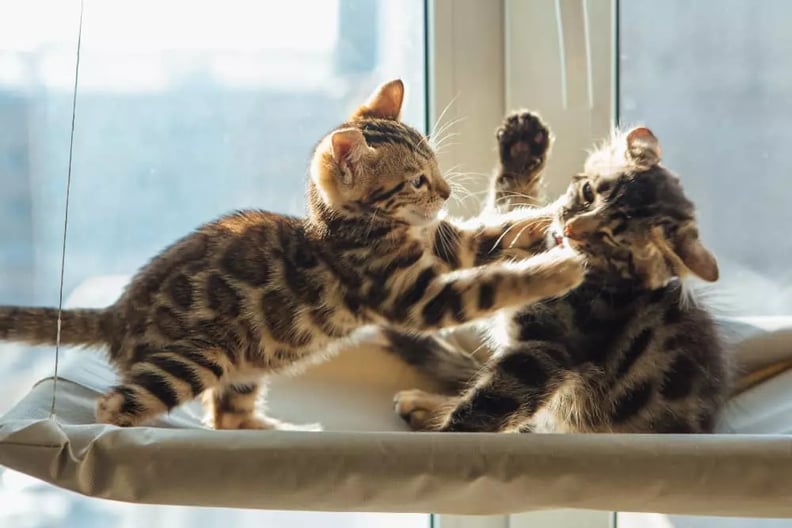
There is no way to know how long it will take your old and new cats to get used to each other until you try. The fact is, the process could take hours, days, weeks, or even months for your cats to be comfortable. Take as long as is needed on each step, and try not to force a relationship.
Allowing one cat to bully another, even when it's not aggressive, can escalate, leading to injury and trauma. If one of your cats starts displaying bully behaviours, no matter how familiar the cats are to each other, you should act quickly to teach better behaviours and make sure that both cats are safe.
Talk to your vet about sudden behavioural changes, as they could be a sign of another more serious issue. Injury, illness, and anxiety can lead a cat to act differently around their siblings.
Frequently Asked Questions
Why do cats fight with each other?
Cats may fight due to territorial disputes, competition for resources, or social hierarchy conflicts.
How can I tell the difference between normal play and aggressive fighting?
Play fighting typically involves chasing, pouncing, and mock fighting. Aggressive behaviour involves hissing, growling, and more intense physical interactions.
What should I do if my cats are fighting?
If cats are fighting, intervene calmly to prevent injury. Use distractions like loud noises or a spray bottle of water.
Can neutering or spaying reduce aggression between cats?
Neutering or spaying can help reduce territorial and hormonal aggression, but it may not completely eliminate all aggressive behaviours.
How can I prevent aggression between new and existing cats?
Carry out slow introductions and let the cats indulge in scent swapping. At first, separate the two cats so they can slowly start to adjust to each other.
Can I use punishment to stop cat aggression?
Punishment can escalate to aggression and damage the human-animal bond that you share with your furry friend. Instead, focus on positive reinforcement, providing safe spaces, and seeking professional guidance if needed.
.png?width=200&height=66&name=logo%20(1).png)

.jpg)
